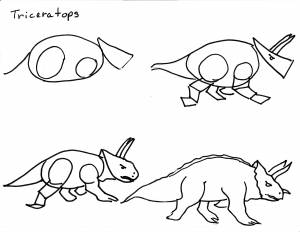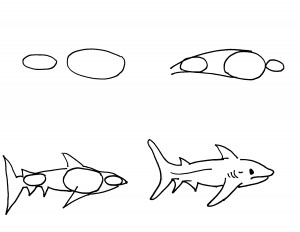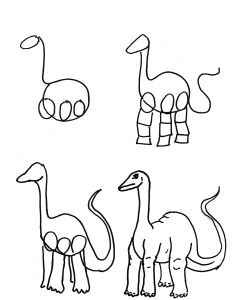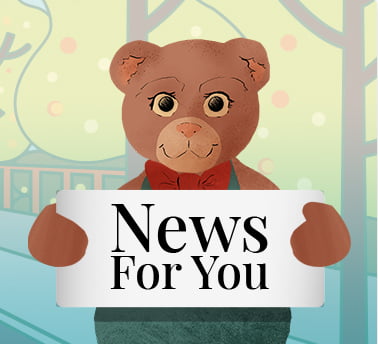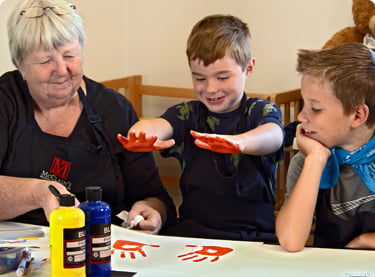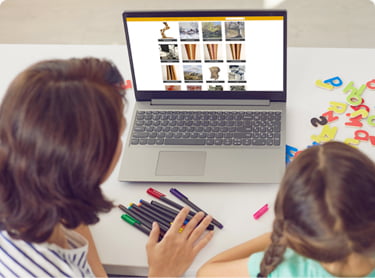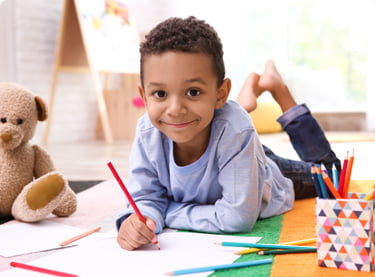
From learning about the anatomy of different mammals to improving hand-eye coordination, drawing animals presents many benefits. A key reason why kids need art is its ability to help them engage with the natural world, and using animal art is an excellent introduction.
Learn the tips and tricks of drawing animals from artist and educator Barbara Mason. Using step-by-step instruction, learn the shapes required to visually represent many different animals. Parents and teachers also can learn how to incorporate these techniques in their lesson plans and creative exercises.
Materials Required for Drawing Animals
The materials required to follow along with the lesson are simply a pencil and paper.
Learn to Draw Animals Using Shapes Video
Join Barbara as she reveals the process of drawing a variety of animals starting from simple shapes. These techniques can be adapted to help draw almost any animal.
Drawing Animals from Simple Shapes With Barbara and Artey Lesson Plan
How to Turn Simple Shapes Into Animal Drawings
Read along with the video transcription below as you absorb the simple steps required to draw animals.
Golden Road Arts is a nonprofit that offers art classes for kids so they can make the most of their own creativity. At Golden Road Arts we believe that children’s access to art is the key to reaching their full potential.
Hi again and welcome back to Golden Road Arts. I’m Barbara Mason and today we’re going to do some fun art lessons. You notice that I have on my mask and Artey, my little mascot back here also has on his mask. And we’re wearing our masks because there’s a pandemic and we don’t want to be sick, and we don’t want to make anybody else sick. But I’m going to take my mask off while I talk to you because I’m the only person in this room, and I don’t think I can make anybody sick because nobody else is here. But when I leave, I’m going to put my mask back on.
Today I want to talk to you about drawing. Everybody wants to learn to draw. It’s not magic. You can learn how to do it, it’s just like you learn how to read, you can learn how to draw.
I want to talk to you a little bit about pencil. There’s a lot of different pencils, and I want to show you this box of pencils. Now, all of these pencils, all of these pencils just draw a pencil line. They’re different hardness. This regular pencil that you have, that you would use here that everybody has to draw with, If you look on this pencil, you see there’s a number on it, and it says #2. Wonder why it says #2? Well, that tells you how hard the pencil is, and this is a pencil that’s very good for just writing. It makes a good nice medium line that you can see. When you have a pencil, that’s a drawing pencil, sometimes they go from H, HB, then they go down to B, then there is a F for fine. This pencil here, that I’m going to draw came out of this container, this pencil says on it 6B. 6B is very, very soft. The softer the pencil, the darker the line. The harder the pencil, the lighter the line.
I’m gonna draw with this pencil because I want you to be able to really see it. The first thing we’re going to draw is a dog, and then we’re going to draw a cat, and things that you have around your house.
In order to be able to draw something, first, you have to be able to look at it. If you don’t have a picture of a dog or a cat, you can look at your dog or cat, and you can look on the Internet to get a picture of a dog or a cat. You know when we talked about drawing things before, we talked about lines, and then we talked about how lines make shapes. Well, if you have lines and you have shapes, you can draw anything, because everything is made up of lines and shapes.
When you look at a dog, you say, OK, (this dog, I’m going to do this one right here.) This dog, he’s kind of a long dog, and he has a body like this. There is his body. Then he’s got a big leg in the back, and he’s got a smaller leg in the front, then he’s got a head, and kind of a nose. This is how you start. You say, OK, I want to see the pieces of this dog how it goes together. We know that this part of his body here, where his back leg is, that is the biggest muscle, and that is what allows dogs to really jump high is that back leg muscle.
Now we’re going to draw him again. I’m going to do another one so we can show him a little further along. We can say, OK, here’s our dog. He’s got a neck which we didn’t have in the other drawing. We’re going to put his neck in. We’re going to put his head in, he’s kind of still got a nose, maybe an ear, and then he’s got his front leg. Dogs legs with you look at a dog’s leg, you have to really look at things to draw them. You can see that your own knee bends this way, like this. But that’s not the way a dog’s leg bends. A dog’s leg bends the other way. So, I am going to erase this. Having an eraser is very, very helpful when you’re drawing. You can always erase it and do it again. A dog’s leg bends this way. So, there’s his front leg. Now, his back leg, he’s got this big muscle, so his back leg goes like this.
Now we’re going to draw him again, and we’re going to get him looking a little more like a dog. But you know, you would just be working on one, and then you just keep drawing on it, and when you get all done, you erase the lines that you don’t want. So we’re going to do his back, and maybe we’re going to give him a tail this time. There is his tail now. We still have his big part of his leg here. It goes like this, because its leg bends the other way. Now we’ve got his little foot, we got his little tummy, his front leg- bends this way too, we got his head, got his ear, and his nose is kind of getting along now. So now, we kind of have something that looks more like a dog.
We really want to refine this to make it look better. So we have our line here. We’re gonna put his tail on. We’re just using lines and shapes. We have our big shape here for his back leg that comes like this. We’ve got his foot. And then we’re going to have his neck that comes up like this. And we’re going to have his head that comes like this now. One thing that we notice is that the dog’s nose is kind of pointed, and we didn’t make it pointed on our other drawings, but we’re going to make it pointed now. He kind of has a little neck there, his ear kind of comes like this. You can look at your dog, and you can see how he looks, which way he goes, what way you want to draw. If you want to just draw from the side or from the front. And then you can see that he comes down kind of like this. And then this leg kind of looks straight in the front, but in the back you can see it still kind of bent out of their way. Now, We cannot have his back who punched up here, but really it would go like that, wouldn’t it?.
So then we can take our eraser and we can say, OK, the lines that we don’t want we can take away. So we can take away this line. No, this is such a dark pencil that’s going to be kind of hard to erase it. Maybe what I will do is I’ll just draw it with my magic marker. So we can take this line and we can say, OK, here’s our dog. We’re going to do his back. I’m gonna do his tail. We’re going to do his back leg. We’re going to do his front leg. We are going to do his nose kind of like this. Maybe get a little smile. And we’re going to do his ear. So this looks a little bit more like a dog. We’re going to put these drawings on the Internet for you so that you’ll be able to look at them, and you’ll be able to draw. You’ll be able to do it step-by-step, just like I’ve done. We have a lot of these: we have one for a dog, we have one for a rabbit, and then we have a whole bunch that are for dinosaurs, because we thought that you might really like to learn how to draw dinosaurs. If you follow along with these, you’re going to be able to learn to draw these things. And then you’re going to be able to look at other things around your house, and you’re going to be able to draw them, because you’re going to look at them and you’re going to make them out of shapes.
And so here’s one when we did a rabbit. You can see this rabbit with just three shapes, almost looks like a snowman. But then as we make it look a little bit more like a rabbit, you can see that we didn’t do much to it to make it look like a rabbit. So you can start drawing these things, and you’re going to learn how to do them. If there’s anything really special that you would like to learn to draw, that you would like us to do a sample for you, you can let us know, and we’ll see if we can get that on the Internet for you.
The other thing I want to do is dinosaurs. I think dinosaurs are so much fun. When my children were little, they loved dinosaurs and my grandchildren loved dinosaurs. So dinosaurs are very special. We’ve got a picture of a dinosaur here. This is, I think, a brontosaurus. One of the things I found out about dinosaurs is the word dinosaur really means big lizard. They certainly looked like lizards, don’t they? Somebody told me today that they think dinosaurs didn’t really make a lot of loud noises, that they sounded more like geese, that kind of honked. Well, we don’t really know what dinosaurs look like. We have their bones, but we really don’t have their outside so we have to guess what their skin look like.
You know dinosaurs are an interesting thing because we have their bones. Because they’re so old, their bones have turned into petrified stone, and they are very, very heavy. Dinosaurs lived so long ago- they lived millions of years ago. If you try to count to a million, and you just started, and you went one, two, three, four, five, six, and you counted to a million, it would take you over 100 days to count to a million. So a million is a lot, really, really a lot.
These dinosaurs lived more than one million years ago. They lived several million years ago, and we actually got a timeline. I found a teacher who lives on the east coast of the United States, and he gave us a picture that he had drawn of a dinosaur timeline. We’re going to put that on the Internet, and you’ll be able to pull that up, and look at it. It’s really pretty. It’s in color, and it’s a fun thing because it shows how many years ago the dinosaurs lived. And boy, it was a long time.
So this is a brontosaurus, and here’s my drawing here on how you draw a brontosaurus. You can see that I started with a circle for his body, and then I can see three legs here: his back leg, and his two front legs. Then I thought, well, how do his legs bend? Do his legs bend the way our legs bend, or do they bend differently? Well, we are not 100% sure how they bend, but I think they probably bend a little bit like dog’s leg bend, so they kind of bend backwards. But this brontosaurus, this one here, his legs kind of look like they’ve bend like people legs, so I’m not real sure how they bend. But anyway you can see I’ve started to do his legs, and then I added his tail, and then I added his face, and I added some little marks that make it look like he’s moving a little bit. And so as you start to do this, you can erase all these other lines that don’t matter as you start to do it. You can see he’s got a big muscle here. A big muscle here, and another muscle here, and then he has got his head. So you can figure out how to do this by looking at our drawings.
Here’s a tyrannosaurus. Tyrannosaurus, he is a little harder to draw. He got a huge back muscle, huge back muscle, because he is standing up on his back legs, he’s not standing on all four legs like the brontosaurus was. So, he is up, and he’s got little tiny short arms, and he’s got up kind of a square looking head. So as you start drawing him with our shapes. You just keep refining the shapes, and then when you get down here you can say, OK, how does his head really look? Well, again, we don’t really know. We have his bones, but we don’t really know what his head looks. So if you make your head look different than the head I’ve drawn, it’ll probably be OK because nobody really knows what dinosaurs look like. So we. Kind of gave him a mean eye, and we give him lots of teeth because after all this tyrannosaurus Rex is a meat eater. Most of the dinosaurs ate plants. But Tyrannosaurus Rex was a meat eater.
When you’re a meat eater, you’re called a carnivore. Not sure where carnivore came from, but probably came from Latin, all the words seemed to come from Latin. Carnivore- “Carni” is a Spanish word that means meat, and “Vore” means to eat. So carnivore means that he was a meat eater.
Brontosaurus that we drew earlier. He was an herbivore. So herbivore means that he ate plants, no meat, just plants. So big, really giant, plant eater that sounded like a goose. I guess, we’re not sure, because it was way before people were living.
Here we’ve got a Triceratops. So triceratops has a really funny head thing, almost like a shovel on the front of his head. He’s got kind of bones down his back, and he’s got spikes. You can see his feet, he’s got the feet that looked like he can really run. He’s a real runner. So you can see how I’ve drawn him step by step by step, and you can do the same thing.
And then here’s a stegosaurus. So the stegosaurus is the guy that’s got all these spikes on his back, and he’s kind of a funny looking dinosaur. When you start drawing and he almost looks like, maybe, a car, one of those cars that you see in cartoons. But as you put him together, he’s got the same kind of legs, his legs bend, these legs bend like dog’s legs. He got kind of a long pointy nose. But look at all these sharp things on his back. I think a Tyrannosaurus Rex would have a hard time eating the stegosaurus, because he’s pretty well protected with all these plates.
The other thing that I found on the Internet, and we are going to put these on the Internet too. So if you cut these out, probably would have to use heavy paper. If you cut these out, and you cut these little slots, and cut these legs, you could stick them in, and your dinosaur would stand up. I think that would be a lot of fun for you to have these, so you can color these anyway you want to because it’s your work.
And here’s a cat. I have a whole stack of these here. Here’s a cat so you can see we started with a circle. Another circle, another circle, then we added his ears. Kind of decided where his face was going to be, and then we kind of got his feed on here, and his head, and finally we have our cat. So you could see that just by using shapes, and using lines, you can draw anything because you just have to really look at it. If you really look at something and see how it’s put together, the pieces that go together with it, the shapes, you’ll be able to draw it. You just have to go slow and really, really look.
And here’s another cat. This is a cat that’s kind of looking right at us. This is a cat kind of from the side. Then we have a rabbit. Now, some of us didn’t like this rabbit, but you know there are a lot of different kinds of rabbits, rabbits can be any way you want, really.
Here’s a bird that’s flying. His wings are up in the air. His wings are up in the air. And here’s a dog that’s looking right at us. He is facing us and you can see that he looks a little different, because he is kind of sitting on his back legs. But his front legs are coming right at us. So it is just a different way of drawing it. If you look at how your dog is sitting, how your cat is sitting, you can say, hm, Where is he sitting? Where is the biggest part of his body? Is the biggest part of his body here? Is it up here? What part of his body is the biggest? If I make my circles, where is it going to fit inside this dog? How am I going to be able to draw it? And you’ll find that you’ll be able to do it.
And here’s a really fun one. Here’s a shark. I know everybody likes to draw sharks. So you can say his biggest part, Is the front part of his body, and then his head, and then the back part of his body. And then he’s got fins. And then when you erase all these parts that you don’t need when you are done, you can see he looks pretty much like a shark. We’ve just added some little marks for his gills, and we’ve added an eye, and a little mark that makes it look like he’s swimming. So if you really look at pictures of fish and of sharks, you’ll be able to draw these.
Here’s a little bird. Here’s an owl. So we’re going to put all of these on the Internet and you’ll be able to do these one by one, and figure out how to draw and when you get done doing these, you’re going to be able to draw a lot better than you thought you could, because it’s not magic, it’s just really looking at things and putting the shapes together. Because everything is made out of lines and shapes.
And here’s a horse. I think horses are very, very hard to draw, so I don’t think this should be the first thing you draw. I think you should wait until you’ve drawn all these other things and then maybe do a horse. Horses are very hard to draw, they have very thin legs that are holding up the weight of their whole body. So they kind of seem almost off balance, but once you figure out how they go together, how their legs bend the opposite way of your legs, you’ll be able to figure out how to draw them, how their neck bands, how their front legs kind of stand. When they run, all four feet are off the ground at once. It’s amazing how horses run. So the more you look at things, the more you be able to draw them. And if you have something really special that you would like to draw with myself and with Artey, you can let us know and we’ll do a demonstration for you, and we’ll put it on the Internet.
I’ve been drawing a long time because I’m not young, but you’re young so you can start now, and by the time you get to be my age, you’ll really be able to draw well. It’s just like anything, the more you do it, the easier it gets, and the better you get at it.
So thanks a lot for visiting me at Golden Road. I’m going to put my mask back on because we’re leaving for the day. I hope that you’ll do a lot of drawings. Thanks so much. Again, this is Barbara Mason and I’ll see you next time.
Golden Road Arts is a nonprofit that offers art classes for kids so they can make the most of their own creativity. At Golden Road Arts we believe that children’s access to art is the key to reaching their full potential. Using simple materials usually found around the house, we explore the basics of the creative process. Together with Barbara, her sidekick, Artey the art bear and other Northwest artists, we invite you to join us on our creative adventure along the Golden Road.
Browse Our Free Library of Art Lessons for Kids
Art education is crucial for a child’s physical, social and cognitive development. At Golden Road Arts, we make it easy to deliver the best quality art tutorials with our accessible video library. To learn more, watch our free art lessons and donate to help with continuing content development.
Samples


